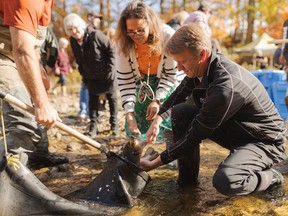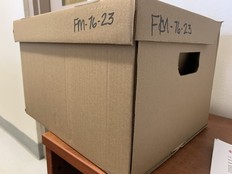The thrill of a returning salmon, back from near-extinction
More than 800 salmon were trucked in and released last week into the Petitcodiac watershed

Article content
Tim Robinson remembers the joy of fishing for trout in Palmer’s Creek when he was a kid in the 1960s.
Not far from his home in the village of Dorchester and just past what was then called the Indian reserve, his father showed him the proper way to angle near the confluence of the Memramcook and Petitcodiac rivers in southeastern New Brunswick.
That included the odd time he caught a special-looking silvery fish.
“He’d say no, ‘that’s not a trout, it’s a juvenile salmon, don’t bring those home, you have to return it to the river,’” said Robinson, who’s now 64.
“It was a small part of the river system, but back when there used to be a healthy Inner Bay of Fundy salmon population, some of the adults would make their way into Palmer’s Creek. The elders don’t forget that. They are well aware that the salmon would come right up through Dorchester and into Fort Folly First Nation.”
In 1968, a causeway was built across the nearby Petitcodiac River in Moncton, the area’s most important salmon run. It blocked the passage of one of five wild Atlantic salmon that would make their way up 33 Inner Bay rivers between New Brunswick and Nova Scotia.
About two decades later, the entire Inner Bay of Fundy run crashed, with most of those rivers having dwindling returns of a few hundred, a far cry from the estimated 40,000 that would annually fight their way up from the sea to their freshwater spawning grounds.
Many theories abound about why the fish disappeared: warming waters, fish barriers, habitat destruction, and pollution.
The loss of those iconic fish, sacred to Indigenous communities and a favourite of anglers, has always bothered Robinson, and it’s the reason he’s thrilled to help bring them back from the brink of extinction.
It’s been a real privilege to be part of something good and positive. But there’s a lot of work yet to be done
Tim Robinson
The director of salmon recovery at Amlamgog (Fort Folly First Nation) has been working all week with different partners, such as Parks Canada and Cooke Aquaculture, to put large wild Atlantic salmon into the Pollett River, the largest tributary of the Petitcodiac, whose causeway gates were finally re-opened in 2010. Today, the causeway is gone, replaced by the Brenda Robertson Bridge.
“It’s awesome,” said Robinson, who has worked on salmon recovery for the First Nation since 1995, training more than 20 Indigenous members to be river technicians along the way. “It’s been a real privilege to be part of something good and positive. But there’s a lot of work yet to be done.”
On Friday, a Mi’kmaq elder performed a traditional water blessing at the Elgin Women’s Institute as large salmon were released into the Petitcodiac watershed.
Through the week, more than 800 big fish were trucked in and released in four different locations.
The salmon are the descendants of broodstock from the Inner Bay of Fundy Rivers preserved at the Department of Fisheries and Oceans Mactaquac Biodiversity facility near Fredericton.
After being released in the rivers, they were allowed to grow until they were the right size. Through a spring catch with nets and electro-fishing in the fall, they were rounded up and sent to the world’s first wild salmon marine conservation farm, in sea pens run by Cooke near Dark Harbour on Grand Manan.
Instead of counting on the fish coming back from sea on their own, conservationists keep them in the pens for up to two years to ensure their survival.
Five years ago, when the ocean-raised fish were first dropped back into the Pollett River, the recovery team only had 75 of the big adults.
But the more that survive, the greater the returns.
This year’s release of more than 800 tagged salmon should be dwarfed by next year’s release, when as many as 1,400 will be returned to the Pollett. Each year, the numbers have increased, and Robinson said the fish seem to be doing well, raised in a harsher winter environment that makes them more resilient than their cousins raised in a hatchery.
The idea is to get the big fish in the river in the fall, in time for them to do their sexy thing.
“They can find their spot, choose their partner and build a salmon nest and spawn,” Robinson said. “It’s more natural than having them stripped as they do at a hatchery, when they grab a female, strip the eggs out into a basin and grab a male and strip the milk to fertilize the eggs. This is adults choosing one another rather than a geneticist choosing off of a mating plan.”
The director said the recovery would be even stronger if more funding came through.
“It’s frustrating that there isn’t as much investment in salmon conservation down here on the East Coast compared to the West Coast. There seems to be a different reality. People in British Columbia will not accept their salmon disappearing, and they insist their politicians do something about it.
“Down here we haven’t had as much investment. In these days of nation to nation talks and reconciliation, you’d think we’d do better.”












Postmedia is committed to maintaining a lively but civil forum for discussion. Please keep comments relevant and respectful. Comments may take up to an hour to appear on the site. You will receive an email if there is a reply to your comment, an update to a thread you follow or if a user you follow comments. Visit our Community Guidelines for more information.